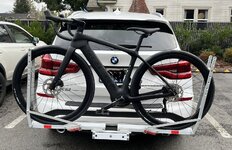Jack Cox
Member
Joining in this thread, seems like we've all chatted before about the Creo. 
As a 2 year Creo SL owner I took the plunge and ordered a Project One SLR9 (Shimano) to replace my admittedly still great Creo. My dealer had one I could see and ride in an SL7 build, although completely the wrong size. I"m XXL on the Creo and this one was a 56.
However, I got enough information to know this is a pretty significant upgrade over the Creo.
Power is relatively similar, a little more than the Creo at the higher cadence, a little lower off the bottom end. The most refreshing part of it was its absolute SILENCE. The lack of thrash compared to the SL motor sold me immediately. I could not hear the motor AT ALL. Some of that is down to my high frequency hearing loss, but while I felt the motor, I never could hear it. The TQ control unit was great and had better features than the mastermind TCU. I will sill want to use my garmin for GPS features, but I could see not using one.
My only (minor) concern was the bar buttons seemed a little cheesy, although well located. The motor unit is TINY. This one will be super stealthy on group rides.
I would never call any bike like this a good deal, but the pricing of the SLR Dura Ace model is comparable to many acoustic bikes in the top groupset category. I really like the idea of going back to double chain rings in the front.
It's going to take 140 days to build it in my color and spec, so I should have it by spring. I'll keep ya'll posted.
As a 2 year Creo SL owner I took the plunge and ordered a Project One SLR9 (Shimano) to replace my admittedly still great Creo. My dealer had one I could see and ride in an SL7 build, although completely the wrong size. I"m XXL on the Creo and this one was a 56.
However, I got enough information to know this is a pretty significant upgrade over the Creo.
Power is relatively similar, a little more than the Creo at the higher cadence, a little lower off the bottom end. The most refreshing part of it was its absolute SILENCE. The lack of thrash compared to the SL motor sold me immediately. I could not hear the motor AT ALL. Some of that is down to my high frequency hearing loss, but while I felt the motor, I never could hear it. The TQ control unit was great and had better features than the mastermind TCU. I will sill want to use my garmin for GPS features, but I could see not using one.
My only (minor) concern was the bar buttons seemed a little cheesy, although well located. The motor unit is TINY. This one will be super stealthy on group rides.
I would never call any bike like this a good deal, but the pricing of the SLR Dura Ace model is comparable to many acoustic bikes in the top groupset category. I really like the idea of going back to double chain rings in the front.
It's going to take 140 days to build it in my color and spec, so I should have it by spring. I'll keep ya'll posted.
